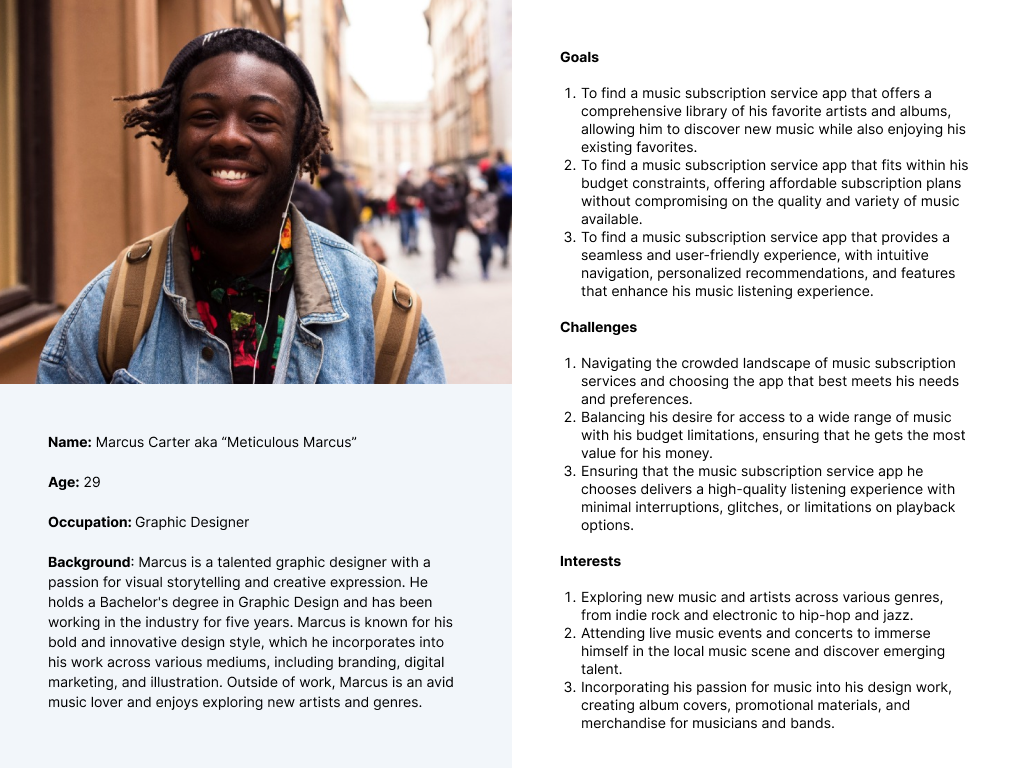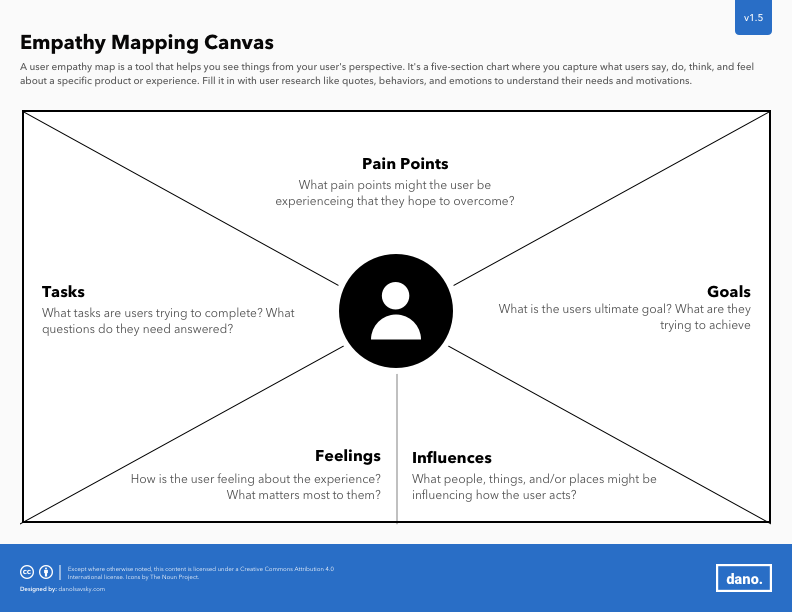Designing with Empathy: Crafting User Personas
UX Research • April 26th, 2023 • by Dan Olsavsky
This lesson immerses us in the art of creating vivid representations of diverse user segments. We’ll explore the meticulous process of defining, refining, and leveraging user personas to capture the essence of various user groups. From empathy mapping to iterative refinement, this lesson unveils the techniques essential for crafting personas that drive empathetic and user-centric design.
Defining and Constructing Comprehensive User Personas
Creating user personas involves defining detailed profiles that represent different user segments. For instance, in a fitness app context, personas might include “Fitness Enthusiast Emma,” outlining her goals, frustrations, and habits. “Beginner Brian” might represent a different segment, highlighting his motivations and challenges. Crafting personas involves extensive research synthesis to capture diverse user characteristics, preferences, and pain points.

Example
Step 1: Research and Data Collection
Gather extensive information through user interviews, surveys, observations, and analytics. Aim to understand user demographics, behaviors, motivations, goals, pain points, and preferences.
Step 2: Identify Patterns and Commonalities
Analyze collected data to identify recurring themes, common behaviors, and shared pain points among users. Group similar characteristics and behaviors to form distinct user segments.
Step 3: Persona Definition
Choose a primary user segment and begin crafting the persona. Give the persona a name, age, background, and job title that aligns with the identified user group. For example:
- Name: Marcus
- Age: 29
- Occupation: Graphic Designer
- Background: Marcus is a talented graphic designer with a passion for visual storytelling and creative expression. He holds a Bachelor’s degree in Graphic Design and has been working in the industry for five years. Marcus is known for his bold and innovative design style, which he incorporates into his work across various mediums, including branding, digital marketing, and illustration. Outside of work, Marcus is an avid music lover and enjoys exploring new artists and genres.
Step 4: Persona Detailing
Add depth to the persona by including details such as:
- Demographics: Location, education, family status.
- Motivations: What drives their actions and decisions.
- Goals: What are they looking for or trying to achieve.
- Challenges and Pain Points: Obstacles they face in achieving their goals.
- Behaviors: How they interact with the product/service.
Step 5: Empathy Mapping
Create an empathy map to visualize the persona’s thoughts, feelings, pains, and gains related to your product/service. For instance, understand Marcus’ feelings about music apps, his thoughts on variety, his pains in choosing one, and his gains interest in finding features that enhance his music listening experience..
Step 6: Validate and Iterate
Share the persona with stakeholders and team members for feedback. Validate the persona’s accuracy through additional user research or user testing. Iterate the persona based on feedback or new insights gathered.
Step 7: Persona Utilization
Leverage the persona across the design process. Use it as a reference point when making design decisions, crafting user journeys, or evaluating features to ensure alignment with user needs and behaviors.
Creating a user persona is an iterative process that involves continuous refinement based on evolving user insights and feedback. Remember, the goal is to create a detailed, representative profile that empathetically captures the needs and motivations of a specific user segment.
Utilizing Empathy Maps for Persona Development
Empathy maps serve as powerful tools for visualizing user personas’ emotions, thoughts, and behaviors. For example, mapping Emily’s feelings about workout intensity or Brian’s thoughts about using fitness tracking features helps in understanding their perspectives. These visual representations aid in empathizing with users, providing deeper insights for persona development by incorporating emotional and behavioral dimensions.

A user empathy map (above) is a chart that helps you understand your user’s perspective. Capture what users say, do, think, and feel about a product or experience using quotes, behaviors, and emotions to uncover their needs and motivations.
How To
Filling out an empathy map involves capturing insights and observations about a user’s thoughts, feelings, actions, and needs. Here’s how you can fill out each section of the empathy map:
- Says: Record direct quotes or statements made by the user. These could be expressions of their needs, desires, frustrations, or aspirations. Use quotes obtained from interviews or user feedback to provide firsthand insights into the user’s thoughts and preferences.
- Thinks: Document the internal thoughts, beliefs, and attitudes of the user. Consider what the user might be thinking about, such as their goals, motivations, concerns, or expectations. Use empathy and intuition to infer what the user might be thinking based on their behavior and verbal expressions.
- Does: Capture the observable actions, behaviors, and interactions of the user. Observe how the user interacts with products, services, or environments in different situations. Pay attention to both routine behaviors and specific actions taken in response to certain triggers or stimuli.
- Feels: Explore the emotions, feelings, and sentiments experienced by the user. Consider how the user might be feeling in various situations, such as happy, frustrated, anxious, excited, or confused. Use empathy to empathize with the user’s emotional state and understand the underlying reasons for their feelings.
- Influences: External factors that may impact the user’s behavior and decision-making process. Consider the people, things, and places that play a role in shaping the user’s actions and preferences. Examples of influences could include friends and family, cultural norms, societal trends, media, advertisements, or environmental factors.
To fill out an empathy map effectively, it’s essential to gather insights from user research, observations, interviews, surveys, and user testing. Engage with users directly to gain a deeper understanding of their experiences, motivations, and challenges. Use empathy and active listening to empathize with the user’s perspective and fill out the empathy map with rich, detailed insights that inform design decisions and solutions.
Refinement Strategies for Iterative Persona Building
Iterative persona building involves continuous refinement based on ongoing research and feedback. For instance, revisiting personas to incorporate new data might reveal that Emma’s goals have evolved, requiring persona adjustments. Collaborating with stakeholders and validating personas through user testing ensures accuracy. Iterative refinement ensures personas stay relevant and reflective of users’ evolving needs.
Example Persona Refinement Strategy
Quarterly Review:
- Every three months, schedule a review of user personas to ensure they remain accurate and relevant.
- Allocate 1-2 hours for the review session.
Step 1: Data Collection (Week 1-2):
- Gather quantitative data from analytics tools, such as website traffic, user engagement metrics, and customer surveys.
- Conduct qualitative research, including user interviews, usability testing, and customer feedback sessions.
Step 2: Analysis and Synthesis (Week 3-4):
- Analyze the collected data to identify patterns, trends, and insights related to user behaviors, needs, and preferences.
- Synthesize the findings to update or refine existing user personas based on the new insights.
Step 3: Persona Workshop (Week 5):
- Host a persona workshop with key stakeholders, including designers, product managers, marketers, and customer support representatives.
- Present the updated personas and discuss the rationale behind the changes.
- Collaboratively review and validate the updated personas to ensure they accurately represent the target audience.
Step 4: Documentation and Distribution (Week 6):
- Document the updated personas, including demographic information, behavioral traits, goals, pain points, and motivations.
- Distribute the updated personas to relevant teams and departments, such as product development, marketing, sales, and customer support.
- Ensure that everyone has access to the latest personas and understands how to use them effectively in their work.
Step 5: Implementation and Monitoring (Ongoing):
- Implement changes and updates to products, services, and marketing strategies based on the insights from the updated personas.
- Monitor user feedback, engagement metrics, and other relevant data to assess the impact of the changes.
- Iterate on the personas as needed based on ongoing research and feedback from stakeholders.
By following this schedule, you can ensure that your user personas remain accurate, actionable, and aligned with the evolving needs of your target audience.
Key Takeaways
- Comprehensive Persona Construction: Building detailed personas involves in-depth research and synthesis to capture diverse user segments.
- Empathy Maps for Deeper Insights: Empathy maps provide visual representations of user emotions and behaviors, enhancing understanding for persona development.
- Iterative Persona Refinement: Continuous refinement based on ongoing research and feedback ensures personas remain accurate and aligned with users’ evolving needs.
Through comprehensive persona construction, utilization of empathy maps, and iterative refinement strategies, designers gain a profound understanding of their users. These insights fuel the creation of tailored and impactful solutions that resonate with diverse user segments.
Thank you for taking the time to read my article! I value your interest and engagement. I invite you to continue the conversation by sharing your thoughts, questions, or feedback in the comments section below. Don’t forget to like and share this article with your network if you found it valuable. And remember to check back in a couple weeks for my next insightful article. Until then, stay creative and keep exploring!



